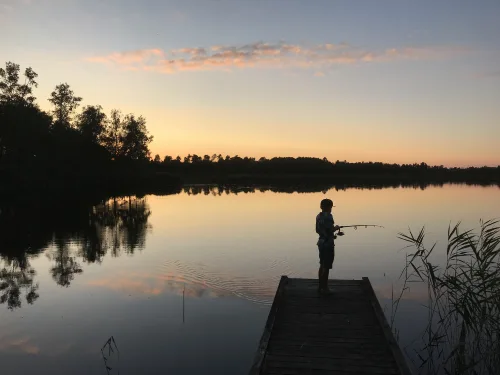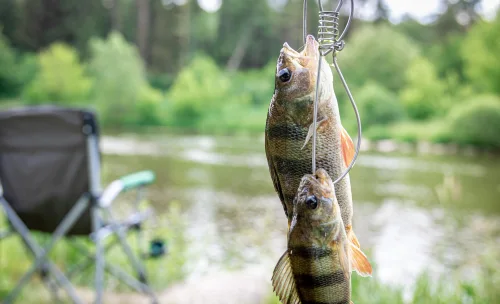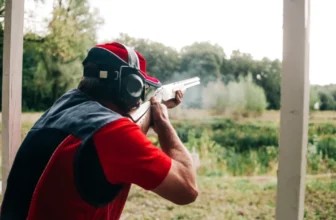Lake Fishing Tips
Lake fishing is the practice of fishing in lakes, which are bodies of freshwater that can be either natural or man-made (reservoirs). It is one of the most popular forms of recreational fishing due to the accessibility of lakes and the variety of fish species they support. Lake fishing can be done from the shore, a boat, or by wading, and it includes various techniques depending on the fish species being targeted, the time of year, and the conditions of the lake.
Popular Fishing Lakes in the US
The U.S. is home to countless lakes, many of which are renowned for their excellent fishing opportunities. Below are some of the most popular fishing lakes in the U.S., known for their variety of fish species, scenic beauty, and accessibility for anglers:
1. Lake Fork (Texas)
- Fish Species: Largemouth bass, crappie, catfish, white bass.
- Why It’s Popular: Known as one of the best bass fishing lakes in the country, Lake Fork holds numerous state records for largemouth bass. It’s a prime destination for anglers looking to catch trophy-sized bass.
2. Lake Okeechobee (Florida)
- Fish Species: Largemouth bass, crappie, bluegill, catfish.
- Why It’s Popular: This massive, shallow lake is one of the most famous bass fishing lakes in the world. It offers year-round fishing opportunities and is a hub for professional bass fishing tournaments.
3. Lake Champlain (New York/Vermont)
- Fish Species: Smallmouth and largemouth bass, northern pike, walleye, lake trout, landlocked salmon.
- Why It’s Popular: Straddling the border between New York and Vermont, Lake Champlain offers diverse fishing habitats, from rocky shorelines to weedy coves, making it ideal for both bass and cold-water species like lake trout.
4. Clear Lake (California)
- Fish Species: Largemouth bass, crappie, bluegill, catfish.
- Why It’s Popular: Clear Lake is one of the best largemouth bass fisheries on the West Coast, with fish often weighing 10 pounds or more. It’s also known for its stunning scenery and year-round fishing opportunities.
5. Lake St. Clair (Michigan)
- Fish Species: Smallmouth bass, walleye, muskellunge (muskie), northern pike, yellow perch.
- Why It’s Popular: Known as a smallmouth bass haven, Lake St. Clair is located between Lake Erie and Lake Huron. It’s also one of the top lakes for catching muskellunge, making it a favorite among trophy-seeking anglers.
6. Lake of the Woods (Minnesota/Ontario)
- Fish Species: Walleye, northern pike, muskie, smallmouth bass, lake trout, perch.
- Why It’s Popular: Spanning the U.S.-Canada border, this massive lake is known for its pristine wilderness and excellent fishing. Walleye and northern pike are abundant, and the lake is one of the best spots to catch monster muskies.
7. Lake Guntersville (Alabama)
- Fish Species: Largemouth bass, crappie, catfish, bluegill.
- Why It’s Popular: This large reservoir on the Tennessee River is famous for its outstanding largemouth bass fishing, and it frequently hosts major bass fishing tournaments. The lake is also scenic, with beautiful rolling hills and forests surrounding it.
8. Lake Tahoe (California/Nevada)
- Fish Species: Lake trout (Mackinaw), kokanee salmon, rainbow trout, brown trout.
- Why It’s Popular: Known for its crystal-clear water and breathtaking alpine scenery, Lake Tahoe is a popular destination for anglers targeting lake trout and kokanee salmon, especially during the cooler months.
9. Toledo Bend Reservoir (Texas/Louisiana)
- Fish Species: Largemouth bass, crappie, catfish, sunfish.
- Why It’s Popular: Toledo Bend is one of the largest man-made reservoirs in the U.S. and is famous for its largemouth bass fishing. The lake is consistently ranked as one of the top bass lakes in the country, and its size offers plenty of space for anglers.
10. Lake Erie (Ohio/Pennsylvania/New York/Michigan)
- Fish Species: Walleye, smallmouth bass, yellow perch, steelhead trout, lake trout. Visit Lake Erie Fishing for more detail!
- Why It’s Popular: Lake Erie is considered the “Walleye Capital of the World” due to its abundant walleye population. It’s also known for excellent smallmouth bass fishing, and anglers come from all over to fish its deep waters for these prized catches.
11. Lake Texoma (Texas/Oklahoma)
- Fish Species: Striped bass, largemouth bass, crappie, blue catfish.
- Why It’s Popular: Lake Texoma is one of the few reservoirs in the U.S. with a naturally reproducing population of striped bass, making it a hotspot for anglers. The lake is also great for catfish and largemouth bass.
12. Kentucky Lake (Kentucky/Tennessee)
- Fish Species: Largemouth bass, smallmouth bass, crappie, bluegill, catfish.
- Why It’s Popular: This massive reservoir is famous for its crappie and bass fishing. With plenty of coves, creeks, and underwater structure, Kentucky Lake offers anglers lots of opportunities for fishing throughout the year.
13. Lake Powell (Utah/Arizona)
- Fish Species: Striped bass, largemouth bass, smallmouth bass, crappie, walleye, catfish.
- Why It’s Popular: Lake Powell is a strikingly beautiful reservoir with red rock cliffs and canyons. It’s known for excellent striped bass and smallmouth bass fishing, as well as its unique setting within the Glen Canyon National Recreation Area.
14. Bull Shoals Lake (Arkansas/Missouri)
- Fish Species: Largemouth bass, smallmouth bass, walleye, crappie, catfish.
- Why It’s Popular: Known for its deep, clear water and abundance of fish, Bull Shoals is a top destination for both bass and walleye anglers. The lake offers great year-round fishing, and its scenic beauty is a bonus for visitors.
15. Falcon Lake (Texas/Mexico)
- Fish Species: Largemouth bass, catfish, crappie.
- Why It’s Popular: Located on the Rio Grande River, Falcon Lake is famous for producing trophy-sized largemouth bass. Despite its remote location, it’s considered one of the top bass fishing lakes in the U.S.
16. Shasta Lake (California)
- Fish Species: Largemouth bass, smallmouth bass, spotted bass, crappie, rainbow trout, brown trout.
- Why It’s Popular: Shasta Lake, the largest reservoir in California, offers great fishing for a variety of species. Its deep waters and underwater structure make it a popular spot for bass and trout fishing.
These lakes are some of the most popular fishing destinations in the U.S. due to their diverse fish populations, beautiful surroundings, and consistent fishing conditions. Whether you’re after trophy bass, abundant walleye, or scenic trout fishing, the U.S. has a wide variety of lakes to suit any angler’s preferences.
Lake fishing
Lake fishing can be incredibly relaxing and rewarding. Here are some tips to help you make the most of your lake fishing experience:
1. Choose the Right Time for Lake Fishing
- Early morning or late evening: Fish are more active during these times when the water is cooler and they come closer to the surface to feed.
- Overcast days: Fish tend to be more aggressive when it’s cloudy as they feel safer in low light.
2. Know Your Fish Species in a Lake fishing
- Different fish species in a lake require specific baits and techniques. For example:
- Bass: Often found near structures like submerged trees, rocks, or docks. Use soft plastics, crankbaits, or jigs.
- Trout: They prefer colder, deeper waters. Using live bait like worms or minnows, or trolling with spoons or spinners can be effective.
- Panfish (e.g., bluegill, crappie): Found in shallow areas near weeds or structures. Small jigs, live bait like worms, or crickets work well.
3. Use the Right Gear for Fishing
- Rod and reel: A medium-action rod with a spinning reel works well for most species.
- Line: Use 6-10 lb test line for general lake fishing. If targeting bigger fish like bass or pike, you might want to use stronger line.
- Tackle: Keep a variety of lures, hooks, and weights in your tackle box. Different fish respond to different presentations.
4. Fish Near Structures
- Fish love to hide around structures like rocks, weeds, fallen trees, docks, or ledges. These areas provide shelter and food for many species.
5. Pay Attention to Water Depth
- Fish are often found at varying depths depending on the time of year, temperature, and species. Use a fishfinder if available, or adjust your fishing strategy by experimenting with different depths using split shot weights or bobbers.
6. Bait Selection for Lake Fishing
- Live bait: Worms, minnows, and leeches work well for most freshwater species.
- Artificial lures: Crankbaits, soft plastics, spinners, and spoons can mimic the movements of prey fish and are effective at triggering strikes.
7. Pay Attention to Water Temperature
- Warm water temperatures push fish into deeper, cooler water, while cooler temperatures often bring them closer to the shore.
8. Patience and Observation
- Take note of what’s happening around you—where other anglers are catching fish, bird activity indicating schools of fish below, and changes in weather.
9. Change Your Technique if Needed
- If you’re not getting any bites, try switching baits, adjusting your depth, or fishing in different locations.

Natural lake fishing. Image by wirestock on Freepik
What is the natural lakes for fishing?
A natural lake is a body of water that forms through natural processes, without human intervention. These lakes are typically created by geological activities, climatic conditions, and natural phenomena that alter the landscape, allowing water to collect and remain in a basin.
Types of Natural Lakes
- Tectonic Lakes
- Formed by the movement of Earth’s tectonic plates. Example: Lake Baikal, the deepest and oldest freshwater lake.
- Glacial Lakes
- Formed from glacial activity, often characterized by their clear water. Example: Lake Superior, one of the Great Lakes.
- Volcanic Lakes
- Formed in the craters of extinct or dormant volcanoes. Example: Crater Lake, known for its deep blue water.
- Oxbow Lakes
- Formed by meandering rivers that create crescent-shaped lakes when a river changes course. Example: Many small oxbow lakes exist along large river systems like the Mississippi River.
- Endorheic Lakes (Closed Basin Lakes)
- Lakes that have no outflow and lose water only through evaporation. These lakes often have high salinity levels. Example: The Dead Sea and the Caspian Sea.
- Rift Lakes
-
- These lakes are formed in rift valleys, where tectonic plates pull apart. Example: Lake Tanganyika in Africa, one of the longest freshwater lakes in the world.
-
Natural Lake Fishing Tips
Fishing in natural lakes can offer unique opportunities due to the diverse ecosystems and water conditions. Here are some tailored fishing tips specifically for natural lakes:
1. Study the Lake’s Structure
- Topography and Depth: Natural lakes often have a mix of shallow areas, deep drop-offs, submerged vegetation, and natural structures like rocks, stumps, and fallen trees. Use a fishfinder or a topographic map of the lake to locate these areas where fish are likely to gather.
- Points and Drop-offs: Fish, especially predatory species like bass and pike, tend to hang around drop-offs, points, and ledges. Cast along these areas for better chances.
2. Observe Seasonal Patterns
- Spring: Fish tend to move toward the shallows to spawn. Target areas with warmer, shallower water near the shorelines or inlets.
- Summer: As the temperature rises, fish often move to deeper, cooler waters. Fish during the early morning or late evening, or target deeper waters during the day.
- Fall: Fish become more active and move closer to shore again in search of food, making it a prime time for fishing.
- Winter: If the lake freezes over, ice fishing is an option, though it requires specific gear and safety precautions.
3. Use Natural Bait for Lake Fishing
- Since fish in natural lakes are accustomed to feeding on local species, using live bait like minnows, worms, or leeches can be particularly effective. Insects, small fish, or crayfish found naturally in the lake’s ecosystem are great choices.
- Imitating Local Prey: Use lures that mimic the appearance and movement of local prey species. For example, soft plastics shaped like local minnows or crankbaits that imitate the swimming motion of the lake’s forage fish.
4. Fish Around Vegetation
- Many natural lakes have healthy aquatic vegetation like weeds, lily pads, and reeds. These areas provide cover for fish and are prime fishing spots for species like bass, perch, and pike. Cast near or into weed beds and retrieve slowly to attract bites.
5. Adapt to Water Clarity
- Clear Water: In clearer lakes, fish are more cautious, so use lighter line (6-8 lb test) and natural-looking baits. Fish may also be deeper to avoid the sunlight, so adjust your depth accordingly.
- Murky Water: In lakes with murkier water, use brighter or more colorful lures, like chartreuse or orange, to help fish locate your bait. Heavier lines and noisier lures can also help attract attention.
6. Time of Day for Lake Fishing
- As with most fishing, dawn and dusk are typically the most productive times, as fish are more active during these low-light conditions. Midday can still be productive if you target deeper waters or shady areas under trees or docks.
7. Target Specific Fish Species
- Bass: Found near structures such as fallen trees, rock formations, or weeds. Use soft plastics, spinnerbaits, or topwater lures, depending on the season and time of day.
- Trout: Often found in colder, deeper water. Use lightweight setups with spinners, spoons, or live bait like worms or minnows. Trolling with small lures can also be effective.
- Pike: These predators love to hide in weedy areas or near drop-offs. Use larger, flashy lures like spoons, spinnerbaits, or jerkbaits.
- Perch and Panfish: Common near the shoreline and shallow weedy areas. Small jigs, worms, or crickets on light tackle are great for catching these fish.
8. Look for Natural Indicators
- Bird Activity: Birds diving into the water can indicate schools of baitfish below, which often attract predatory fish.
- Insect Hatches: If you see a lot of insect activity on the surface, fish may be feeding on them. Use surface lures or flies that imitate the hatching insects.
9. Be Prepared for Changing Weather
- Natural lakes are subject to sudden weather changes, so always check the forecast before heading out. Overcast, slightly windy days can be excellent for fishing, as the reduced sunlight and choppy water make fish less wary.
10. Experiment with Lure Types
- Topwater Lures: Great for early morning or late evening when fish are more active near the surface.
- Crankbaits and Spinnerbaits: These are effective when covering a lot of water and searching for active fish.
- Soft Plastics: Use soft plastic worms or lizards near structures for bass. Vary the speed of your retrieve based on water temperature and fish behavior.
11. Catch and Release Considerations
- Natural lakes often have delicate ecosystems, so practicing catch and release can help preserve fish populations. If you do plan to keep fish, be mindful of local regulations and limits.
By understanding the unique characteristics of natural lakes and adjusting your strategies accordingly, you can greatly improve your chances of a successful fishing trip!
What is man-made lakes?
A man-made lake, also known as an artificial lake or reservoir, is a body of water that is intentionally created by human intervention. These lakes are typically constructed by damming rivers or streams, excavating land, or altering natural landscapes to collect and store water. Man-made lakes are used for a variety of purposes, including water supply, irrigation, hydropower generation, flood control, recreation, and industrial use.
Finding fish in lake fishing
Finding fish in lakes, whether natural or man-made, can be challenging without the right approach. Here are some effective strategies and tips for locating fish in lakes:
1. Know the Fish Species and Their Habits
- Different fish species behave differently and prefer specific habitats. Before fishing, research the types of fish in the lake and their habits, feeding times, and preferred environments.
- Bass: Like to hide around structures (fallen trees, rock piles, docks) and weed beds.
- Trout: Often found in deeper, cooler water, especially during the warmer months.
- Panfish (Bluegill, Perch, Crappie): Tend to stay in shallower, weedy areas or near submerged structures.
- Pike and Walleye: Often found near drop-offs, submerged vegetation, or ambush points.
2. Use a Fishfinder or Sonar for Lake Fishing
- Fishfinders: These devices use sonar to scan the underwater terrain and detect fish. They can help you see:
- Depth of the water
- Underwater structures like drop-offs, stumps, and vegetation
- Schools of fish or individual fish beneath your boat
- Modern fishfinders also show water temperature, which can help you locate species that prefer specific temperatures.
3. Look for Structure of Lake Fishing
- Fish often gather around underwater structures because they provide cover, shade, and feeding opportunities. These structures include:
- Weed beds: Fish like to hide in or near aquatic plants to hunt smaller fish and insects.
- Rocks and boulders: Rocks can provide shade and places to hide, attracting fish.
- Submerged trees or stumps: These areas offer protection and are excellent spots for bass, crappie, and pike.
- Drop-offs and ledges: Predatory fish tend to patrol the deeper edges of drop-offs, where they can ambush prey moving between deep and shallow water.
4. Fish Around Points, Inlets, and Outlets
- Points: These are areas where the shoreline extends into the water. Fish often gather around these points because currents bring food to them.
- Inlets: These are places where streams or rivers flow into the lake, bringing in food and oxygen-rich water. Fish gather here, especially after rain when food is washed into the lake.
- Outlets: Areas where water flows out of the lake can also be productive, as fish congregate in these spots to feed on insects and small fish carried by the current.
5. Consider Water Depth and Temperature of the Lake Fishing
- Fish move to different depths depending on water temperature and the season. In general:
- Spring: Fish tend to be in shallower waters, often near shorelines, as they prepare to spawn.
- Summer: As temperatures rise, fish often move to deeper, cooler water during the heat of the day but may return to the shallows during early morning or late evening.
- Fall: Fish become more active and return to shallower waters as the temperatures cool, feeding in preparation for winter.
- Winter: Fish tend to stay in deeper water where temperatures are more stable.
Use a thermometer to check water temperatures and adjust your fishing strategy accordingly. Different species have different temperature preferences:
- Bass: 60-75°F (15-24°C)
- Trout: 50-65°F (10-18°C)
- Panfish: 60-75°F (15-24°C)
6. Fish During Active Times
- Fish are generally more active and easier to catch during certain times of day and weather conditions:
- Early Morning and Late Evening: These are the best times to fish, as fish are more likely to be feeding in the shallows.
- Overcast or Rainy Days: Fish are more comfortable moving in shallow waters when it’s cloudy, making them easier to catch.
7. Observe Nature and Wildlife
- Birds: Birds diving into the water can signal schools of baitfish below, which often attract larger predatory fish.
- Surface Activity: Ripples, splashes, or swirls on the water surface can indicate feeding fish. Fish feeding on the surface create disturbances that you can see even from a distance.
- Insect Hatches: If you see a lot of insects hatching on the water’s surface, it can trigger a feeding frenzy among fish.

Fish species. Image by pvproductions on Freepik
What fish species can you catch in a lake fishing?
Lakes support a wide variety of fish species, depending on the region, climate, and characteristics of the lake (natural or man-made, warm or cold, deep or shallow). Here are some common freshwater fish species you might encounter when fishing in lakes:
1. Bass in a lake fishing
- Largemouth Bass: Found in warmer lakes across North America. They prefer shallow waters with plenty of vegetation, fallen trees, or structures where they can ambush prey.
- Smallmouth Bass: Typically found in cooler, clearer lakes with rocky bottoms. They prefer deeper waters compared to largemouth bass.
- Spotted Bass: Similar to smallmouth bass but often found in reservoirs and lakes with less structure.
2. Trout
- Rainbow Trout: Common in colder, clearer lakes, often stocked in lakes across the U.S. and Europe. They prefer cooler waters and are often found at varying depths depending on the season.
- Brown Trout: Thrive in deeper, cooler lakes. Known for their elusive nature, brown trout often hide near structures or deeper water.
- Lake Trout: Native to deeper, colder lakes in North America. They are often found near the bottom in the summer months and can grow to significant sizes.
3. Pike
- Northern Pike: These predatory fish are common in colder lakes in North America and Europe. They lurk in weedy areas or near submerged structures, waiting to ambush prey.
- Chain Pickerel: Smaller relatives of pike, often found in lakes with a lot of vegetation in North America.
4. Walleye
- Walleye are popular in many northern U.S. and Canadian lakes. They prefer deeper waters during the day but move to shallower areas in low-light conditions. Walleye are prized for their excellent taste.
5. Panfish
- Bluegill: A very common species in lakes across North America. Bluegill are usually found in shallow, weedy areas and are a favorite for anglers of all ages.
- Crappie (Black and White): Found in many lakes, crappie are typically around submerged structures like brush piles, docks, or stumps. They bite best in early morning and late evening.
- Perch (Yellow Perch): Found in cooler lakes, particularly in the northern U.S. and Canada. Yellow perch are schooling fish and can often be caught in large numbers.
6. Catfish
- Channel Catfish: Common in lakes throughout North America, particularly in warmer regions. They prefer deeper waters and are often bottom feeders.
- Flathead Catfish: A larger, more elusive species, flathead catfish can be found in larger lakes with plenty of cover, such as submerged logs or rock piles.
- Blue Catfish: Found in southern U.S. lakes and rivers. Known for their size, blue catfish can grow to impressive weights.
7. Carp
- Common Carp: Found in lakes around the world, carp are large, strong fish that are often caught using bottom-fishing techniques. They are common in both natural and man-made lakes.
- Grass Carp: Often stocked in man-made lakes to control aquatic vegetation, these large fish can also be targeted by anglers.
8. Sunfish in a lake fishing
- Besides bluegill, other types of sunfish, such as Redear Sunfish and Green Sunfish, can be found in lakes, particularly in the U.S. They prefer warm, shallow waters near vegetation.
9. Striped Bass and Hybrid Striped Bass
- In some lakes, especially reservoirs, striped bass or hybrid striped bass (a cross between striped and white bass) are stocked. They are aggressive fighters and are often found in deeper parts of lakes.
10. White Bass
- White bass are often found in schools and prefer larger lakes or reservoirs. They are fast swimmers and can be caught in significant numbers during their seasonal runs.
11. Salmon in a lake fishing
- In certain lakes, especially large cold-water lakes like those in the Great Lakes region, species of salmon such as Chinook and Coho Salmon are stocked or naturally reproduce. These fish migrate through rivers but can also be targeted in the lakes themselves.
12. Muskellunge (Muskie)
- Often found in northern lakes, muskellunge are large, elusive predators similar to northern pike. They tend to hide in dense weeds or near large structures and are a trophy species for many anglers.
13. Tilapia
- Found in warm, tropical, or subtropical regions, tilapia are often present in man-made lakes, especially where they’ve been introduced for aquaculture or aquatic plant control.
14. Sturgeon
- In some deep, cold lakes, especially in North America and Europe, sturgeon can be found. They are ancient, bottom-feeding fish that can grow to impressive sizes, though they are usually protected by strict regulations.
15. Bowfin (Amia calva)
- Found in weedy, swampy lakes and ponds across the eastern U.S., bowfin are a prehistoric species that are known for their powerful fights on the line.
The types of fish you can catch in a lake fishing vary depending on the lake’s climate, depth, water temperature, and whether it is stocked or naturally inhabited. Knowing the species present and their habits can greatly improve your chances of a successful fishing trip.








